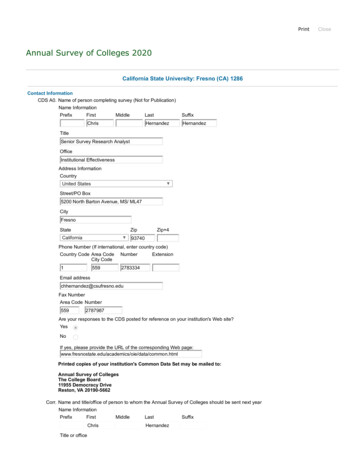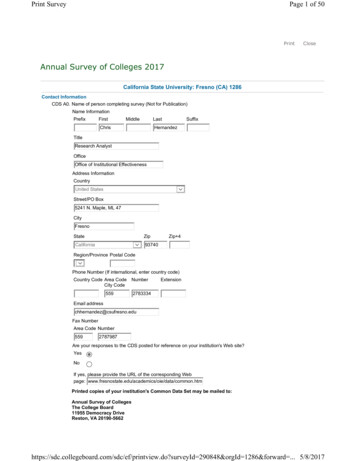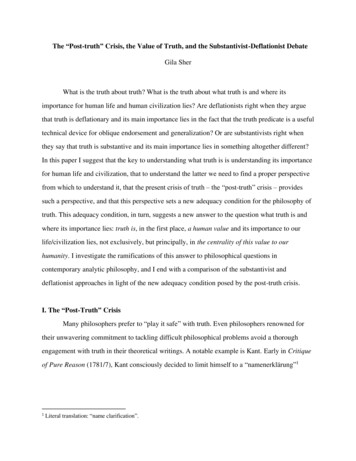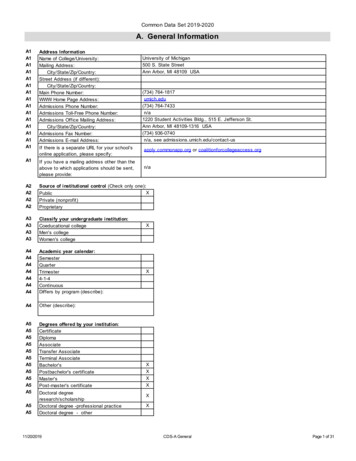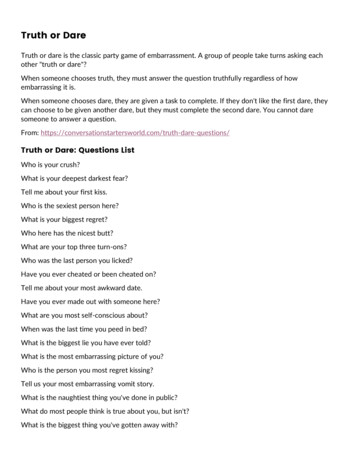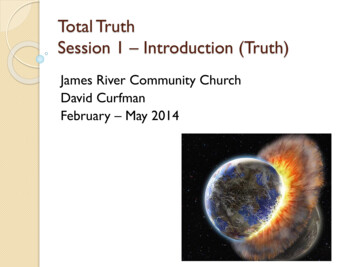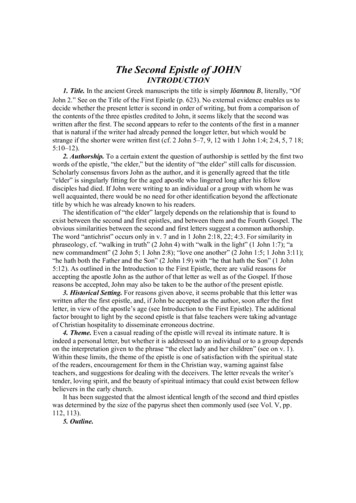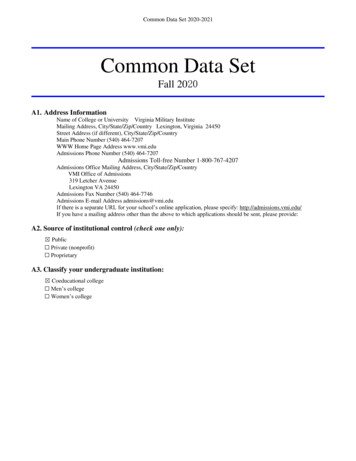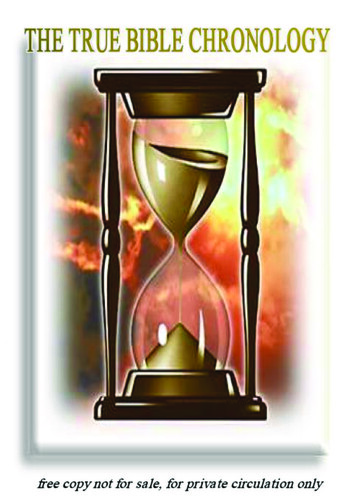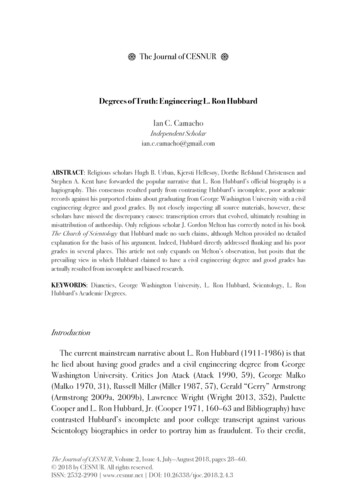
Transcription
The Journal of CESNUR Degrees of Truth: Engineering L. Ron HubbardIan C. CamachoIndependent Scholarian.c.camacho@gmail.comABSTRACT: Religious scholars Hugh B. Urban, Kjersti Hellesøy, Dorthe Refslund Christensen andStephen A. Kent have forwarded the popular narrative that L. Ron Hubbard’s official biography is ahagiography. This consensus resulted partly from contrasting Hubbard’s incomplete, poor academicrecords against his purported claims about graduating from George Washington University with a civilengineering degree and good grades. By not closely inspecting all source materials, however, thesescholars have missed the discrepancy causes: transcription errors that evolved, ultimately resulting inmisattribution of authorship. Only religious scholar J. Gordon Melton has correctly noted in his bookThe Church of Scientology that Hubbard made no such claims, although Melton provided no detailedexplanation for the basis of his argument. Indeed, Hubbard directly addressed flunking and his poorgrades in several places. This article not only expands on Melton’s observation, but posits that theprevailing view in which Hubbard claimed to have a civil engineering degree and good grades hasactually resulted from incomplete and biased research.KEYWORDS: Dianetics, George Washington University, L. Ron Hubbard, Scientology, L. RonHubbard’s Academic Degrees.IntroductionThe current mainstream narrative about L. Ron Hubbard (1911-1986) is thathe lied about having good grades and a civil engineering degree from GeorgeWashington University. Critics Jon Atack (Atack 1990, 59), George Malko(Malko 1970, 31), Russell Miller (Miller 1987, 57), Gerald “Gerry” Armstrong(Armstrong 2009a, 2009b), Lawrence Wright (Wright 2013, 352), PauletteCooper and L. Ron Hubbard, Jr. (Cooper 1971, 160–63 and Bibliography) havecontrasted Hubbard’s incomplete and poor college transcript against variousScientology biographies in order to portray him as fraudulent. To their credit,The Journal of CESNUR, Volume 2, Issue 4, July—August 2018, pages 28—60. 2018 by CESNUR. All rights reserved.ISSN: 2532-2990 www.cesnur.net DOI: 10.26338/tjoc.2018.2.4.3
Degrees of Truth: Engineering L. Ron Hubbardthese critics have addressed discrepancies in the Church of Scientology’s earlypromotional information about Hubbard. Where their criticism becamedishonest, however, was in evaluating prior to having all of the data, rather thantrying to seek and understand the discrepancy causes.Meanwhile, the Church of Scientology’s Public Relations Office attacked itscritics’ reputations through its Freedom magazine and various websites (Churchof Scientology International 2011 and STAND League 2018) yet removed allreferences to Hubbard’s graduation, good grades and a B.S. (Bachelor ofScience) in Civil Engineering in its later biographies. Having provided noexplanation for revising their founder’s biography, however, the churchseemingly agreed with its critics. In short, as they revised their founder’sbiography, the church largely employed similar tactics to its critics rather thanhaving explained the discrepancies. As a result, religious scholars including HughB. Urban (Urban 2011, 32 and Urban 2015, 137–38), Kjersti Hellesøy(Hellesøy 2014, 257–58), Dorthe Refslund Christensen (Christensen 2005,227) and Stephen A. Kent (Kent 2001, 95 and Kent and Lane 2008, 117) haveaccepted the critics’ argument that Hubbard and the Church of Scientologyintentionally lied about his grades, graduation and civil engineering degree. Onlyscholar J. Gordon Melton noted that the church erred—not Hubbard—albeitwithout providing any explanations for his claim (Melton 2000, 58 and 75).Indeed, much evidence shows that Hubbard openly discussed his poor grades andnonexistent college degree. In light of the number and variations of discrepanciesregarding Hubbard’s alleged civil engineering degree claims, it became evidentthat a thorough, exhaustive, and comprehensive review was needed to evaluatenot only how these discrepancies originated, but who if anybody was doing thedeceiving.AcknowledgementsSpecial thanks are given to Donald Westbrook, lecturer for the Center for theStudy of Religion at UCLA, for his mentorship and having provided extensivenotes on this research. Editors Alison Perruso and Fred Marks at Marquis Who’sWho, Inc. both provided incredible insight and a new understanding into theirresearch, publication and publishing process, which provided pivotal informationfor the paper. Of course, much of this work would not have been possible without The Journal of CESNUR 2/4 (2018) 28—6029
Ian C. Camachothe assistance of the History and Genealogy Department at the Los AngelesPublic Library, the librarians at the George Washington University SpecialCollections Department, and the archivists at the National Archives and RecordsAdministration. Margaret Lake of ScientologyMyths.com, Michael Snoeck at thewebsite WiseOldGoat.com, Max Hauri of the True Source Scientology Foundationand Andreas Gross of the blog Scientology: Original 1972 aided by providinghard-to-find original Scientology resources. Patricia Krenik, Lousie and KarenWilliams, and Antony Phillips also assisted with providing the years of births anddeaths for many lesser known figures. Personal thanks go to Randy Smith, KayChristenson, Mary Blackford, Tristan Camacho and most of all Olga Fragoso fortheir tireless support and patience in reading, editing, listening, researching,suggesting and revising the numerous drafts of this paper. Finally, special thanksgo to Professors J. Gordon Melton and Massimo Introvigne for having agreed toread and ultimately publish this paper at the highest professional level, and ofcourse the peer reviewers for their useful comments.The Current NarrativeAlthough such discrepancies at first might seem relatively insignificant to mosthistorians, because Hubbard founded Dianetics and Scientology and had a largeimpact on millions of people, his critics have not only scrutinized his life and allpurported claims, but also have used any discrepancies as evidence to discredit allof these subjects as being rife with deception. Malko justified why the civilengineering discrepancy remained central to the critics’ arguments after havingalleged Hubbard made these claims:Hubbard’s career at George Washington University is important because many of hisresearches and published conclusions have been supported by his claims to be not only agraduate engineer, but “a member of the first United States course in formal education inwhat is called today nuclear physics.” The facts are that Hubbard never received a Bachelorof Science degree in civil engineering. He flunked freshman physics, was placed onprobation in September of 1931, and failed to return to the university after the 1931–32academic year. In later years, in addition to the “C.E.” which he allowed to appear after hisname, he added a “Ph.D.” (Malko 1970, 31).As with many other critics, Malko drew his conclusion largely from theDecember 1959 Church of Scientology publication A Brief Biography of L. RonHubbard, which stated that Hubbard earned a “B.S. in Civil Engineering” from30 The Journal of CESNUR 2/4 (2018) 28—60
Degrees of Truth: Engineering L. Ron HubbardGeorge Washington University in 1934 (Eddy 1959, 4). Yet Hubbard droppedout in 1932, never having completed his civil engineering degree. Furthermore,as critics emphasize, most of his grades were below average (NARA 1932).Figure 1. A Brief Biography of L. Ron Hubbard as publishedby the Church of Scientology in 1959. The Journal of CESNUR 2/4 (2018) 28—6031
Ian C. CamachoFigure 2. Courtesy of Elisabeth Kaplan, George WashingtonUniversity Special Collections Department.Ex-Scientologist Atack allowed the church to explain:Scientology official [at the time] Vaughn Young says the idea that ‘C.E.’ stands for ‘CivilEngineer’ is mistaken. Apparently the initials represents [sic] a certificate awarded in theearly days of Scientology (Atack 1990, 59).32 The Journal of CESNUR 2/4 (2018) 28—60
Degrees of Truth: Engineering L. Ron HubbardYet no Scientology documents supported Young’s statement; while there wereB. Scns. (Bachelors of Scientology) and D. Scns. (Doctors of Scientology), noC.E. appeared outside of the C.E.C.S.—the Committee of Examination,Certification and Services (Hubbard Communications Office 1955, 4 and Steves1954, 1 & 8). Even if one considered that C.E. could have indicated otherScientology titles like “Course Examiner” or “Chief Executive,” no otherScientologist had a “C.E.” after their name in any church publications around thistime except for Hubbard. The C.E. most definitely referred to Hubbard as a CivilEngineer. Thus, it would appear that both L. Ron Hubbard and the Church ofScientology lied about both his grades and college degree.Not only have popular journalists and Scientology critics ended theirinvestigations here, but most religious and historical scholars have based theirconclusions on this same data. Urban grounded his hagiography theory aroundHubbard’s purported claims of having a degree:Hubbard claimed that he had mastered the sciences, studying engineering [and] atomicphysics at George Washington University [ but] had merely enrolled in one introductorycourse on molecular and nuclear physics at George Washington University, receiving agrade of F [ ] Thus Hubbard’s autobiography is perhaps best understood not as anaccurate historical chronicle but rather as a kind of “hagiographic mythology”—that is, anidealized narrative composed self-consciously of mythic themes (Urban 2015, 137–38).In an earlier analysis Urban even emphasized that “in mathematics [Hubbard]earned nothing higher than a D” after having interpreted his data through acritical lens:[W]e accept the Hubbard story not as an accurate historical document but as anintentionally constructed ‘hagiographic mythology’ [ ] Perhaps the one truly uniquefeature of Hubbard’s biography is that he was himself a prolific author of science fiction andfantasy tales and thus had an unusually creative hand in the elaboration of his ownnarrative (Urban 2011, 32).Urban’s views directly influenced Hellesøy, who repeated his narrative:Hugh Urban characterizes the official biography of Hubbard, as presented by the CoS, as akind of hagiography, an idealized narrative built around mythic themes [ ] Hubbard wentto George Washington University for two years. According to the hagiographic account,Hubbard was an engineer [ ] Critical investigation has demonstrated that he never evenfinished any of his degrees (Hellesøy 2014, 257–58).Christensen then used these conclusions as both the title and subject of heressay: “Inventing L. Ron Hubbard: On the Construction and Maintenance of the The Journal of CESNUR 2/4 (2018) 28—6033
Ian C. CamachoHagiographic Mythology of Scientology’s Founder” (Christensen 2005, 227).Meanwhile, Kent used Miller’s claims regarding these discrepancies as the basisfor diagnosing Hubbard with a narcissistic personality disorder (Kent and Lane2008, 117). Despite popular and academic agreement that Hubbard claimed tohave earned an undergraduate degree with good grades, virtually no evidencecorroborated these conclusions.The Scandal of BibliographiesThe index page to A Brief Biography revealed Elanore Eddy (1921–1994) asthis issue’s Ability editor—not Hubbard (Eddy 1959, 2). Nevertheless, Cooperstated that “his son [L. Ron Hubbard, Jr.] claims his father really wrote it [A BriefBiography of L. Ron Hubbard]” (Cooper 1971, 160). If L. Ron Hubbard Jr.’sclaims were true, then it stands to reason that his father either wrote under thepseudonym Elanore Eddy or wrote it and placed the blame on her. If not, thenEddy either wrote it or copied the biography from outside sources. Regarding thepseudonym argument, a photo from the 20th Scientology A.C.C. (AdvancedClinical Congress) in Washington, D.C showed that Elanore Eddy existed(Ability 1958, 10).Figure 3. Photo with Elanore Eddy as published by the Church of Scientology in 1958.34 The Journal of CESNUR 2/4 (2018) 28—60
Degrees of Truth: Engineering L. Ron HubbardWith the pseudonym possibility eliminated, what follows hereafter willexamine the sources and therefore the basis of authorship claims regarding ABrief Biography of L. Ron Hubbard. The 1959 Church of Scientology biographyof Hubbard cited four sources:The Biographical Encyclopedia of the World,Who’s Who In The East (U.S.)Who Knows and What (Standard Reference of Technical Experts)Who’s Who In the South and Southwest (U.S.).Although this issue of Ability magazine provided no dates nor specificsregarding which editions of these books were used, it also stated: “[t]he followingis taken from the sixth edition of ‘Who’s Who In the South and Southwest’”(Eddy 1959, 4). This would explain why the entry for L. Ron Hubbard in Who’sWho in the South and Southwest appeared virtually identical to A Brief Biographyof L. Ron Hubbard. The Scientology biography virtually replicated the Who’sWho entry, with the exception of some cases where it used unabridged terms, forexample “Engring.” turned into “Engineering,” presumably for improvedreadability (Marquis Who’s Who 1959, 395). The fault therefore did not lieentirely with Eddy, for she accurately transcribed Hubbard’s biography fromWho’s Who in the South and Southwest. Rather, her error was in not factchecking against the other three sources. Nevertheless, Cooper claimed thatHubbard directly lied about this information:In his Brief Biography, he said he had graduated from Columbian University and in Who’sWho in the Southwest (they claim he supplied the data) (Cooper 1971, 162).Cooper could not have used either source as the basis for this claim, primarilybecause neither A Brief Biography nor Who’s Who in the South and Southwesteven mentioned Columbian University. In fact, no printed Scientology materialseven referenced Columbian University, except for A Report to Members ofParliament on Scientology, which mentioned Columbian College:L. R. Hubbard attended Swavely Prep. School, Manassas, Virginia, and Woodward Prep.School, Washington DC, USA and Columbia [sic] College, George Washington University,Washington DC in 1932. Attended Princeton University post-graduate (Public RelationsBureau 1969).The World-Wide Public Relations Bureau published this document, however,not Hubbard. For that matter, it remains unclear from when she sourced her The Journal of CESNUR 2/4 (2018) 28—6035
Ian C. Camachoinformation, as Columbian University was the name for George WashingtonUniversity before 1904, while Columbian College actually resides within GeorgeWashington University, itself once called Columbian College (GW Libraries2017). These facts have revealed Cooper’s statement to be entirely unfounded.Interestingly, although Cooper’s aside “they claim he supplied the data” furtherattempted to assign the entry’s authorship to Hubbard and away from thepublishers of Marquis Who’s Who, when coupled with the fact that Eddytranscribed Who’s Who in the South and Southwest almost verbatim, the questionof authorship shifted from one of Hubbard or Eddy to that of Hubbard or theMarquis Who’s Who editors.In any case, A Brief Biography of L. Ron Hubbard must have cited Who’s Whovolumes before 1960 because the Ability issue in which it appeared had a 1959copyright with an upcoming congress listed on 1 January 1960. As the sixthedition of Who’s Who in the South and Southwest published in 1959, this wouldhave also made it the last Who’s Who published before A Brief Biography. As L.Ron Hubbard did not appear in earlier editions of Who’s Who in the South andSouthwest, and because The A. N. Marquis Company also held the rights to bothWho Knows—and What and Who’s Who in the East, the information in theearlier editions of one of these series almost certainly influenced the later editionsof the other series, especially if used as a means of data verification.The next earliest entries for L. Ron Hubbard appeared in both the 1949 and1954 editions of Who Knows—and What Among Authorities, Experts, and theSpecially Informed, which Ability magazine mistitled as “Who’s Who and What(Standard Reference of Technical Experts).” Both books incorrectly showedHubbard with a “BS ‘34 (George Washington U)” (Marquis 1949, 306 andMarquis 1954, 327–28). These two books also noted that his last academicachievement was “Student ’45 (Sch Mil Govt, Princeton)” (Marquis 1949, 306and Marquis 1954, 327–28). Although Cooper cited neither of these books, shefurther claimed that Hubbard also lied about his time at Princeton:As for the Princeton School of Government that he says he attended, it was the PrincetonSchool of Military Government, and he went there only three months in what was possibly awar service course (Cooper 1971, 163).If Hubbard submitted the data as Cooper claimed, then he did not lie about thisstatement. Hubbard definitely completed additional Naval training from 1944–45 at the School of Military Government in Princeton University (Dyson 1979).36 The Journal of CESNUR 2/4 (2018) 28—60
Degrees of Truth: Engineering L. Ron HubbardFurthermore, both the 1949 and 1954 editions of Who Knows—and WhatAmong Authorities, Experts, and the Specially Informed by Marquis Who’s Whoclearly listed him as a “Student ’45 (Sch Mil Govt, Princeton).”What rendered Cooper’s claim all the more unfounded was that Hubbardexplicitly explained that he studied military government at Princeton in a 29October 1955 lecture:During the latter part of the war, I got the notion that nobody knew what they were fightingabout so I took the opportunity of taking some training in military government [ ] And Iwent back to Princeton University and took a course in military government (Hubbard1955c, 5).Hubbard explained in another lecture on 7 July 1957 that he did not attendColumbian College:I used to sit over in the engineering school and some of my pals in the Columbian Collegewould come over and they’d say, “Oh, my God, I can’t pass this examination or write thispaper.” And I’d take their textbook on psychology and write the paper for them. They’d domy mathematics! (Hubbard 1957c, 4).While true that in an earlier 19 July 1954 lecture Hubbard mentionedPrinceton University, he did not mention its school of military government: “I amtalking to you now from material given to me by the professor of ethnology atPrinceton University where I studied” (Hubbard 1954a, 6). Also, in a 15September 1964 lecture he omitted the word military:Now, you maybe think it isn’t a new technology, but I was taught at Princeton in their schoolof government and taught very well on a lot of these points (Hubbard 1964b, 16).Neither of these two latter statements supported Cooper’s claim orcontradicted Hubbard’s previous two statements, however, as all of their contextsinvolved what Hubbard had learned about military governance.Cooper’s Bibliography of Sources Consulted page further revealed that sheignored the other books cited in A Brief Biography—let alone their prioreditions—and several primary Scientology sources (Cooper 1971,Bibliography). Had Cooper reviewed the other cited book series, then she wouldhave noticed discrepancies in the 1946 The Biographical Encyclopedia of theWorld, the only entry in any of the four series with a photo of Hubbard. This entryalso contained significant departures from later entries, as it did not list his timeat the Princeton School of Military Government in 1945, which occurred oneyear before publication. Although the entry still incorrectly showed Hubbard with The Journal of CESNUR 2/4 (2018) 28—6037
Ian C. Camachoa degree in Civil Engineering from George Washington University, it betterresembled his college transcript as it stated that he graduated in 1932, the year heleft (Institute for Research in Biography 1946a, 946). This discrepancy ingraduation years suggested that there were alterations that occurred in earlierseries.Figure 4. 1946 The Biographical Encyclopedia of the World entry for L. Ron Hubbard.38 The Journal of CESNUR 2/4 (2018) 28—60
Degrees of Truth: Engineering L. Ron HubbardThe Who’s Who in the East series fully explained the errors. While the thirdedition only showed Hubbard’s name, the reference page indicated a full entry inprior “Marquis biographical reference works” as per the asterisk by Hubbard’sname (Marquis 1951b, 1223 and Marquis 1951c, 1203). Under the copyrightpage, however, the only prior “Marquis biographical reference” was volume twofrom 1948 (Marquis 1951a, Copyright Notice). That volume once again did notshow Hubbard at the Princeton School of Military Government (Marquis 1948,854). This omission would undermine some claims that Hubbard inflated hiscollege achievements if “he supplied the data” to the Marquis publishers. The1948 volume showed Hubbard with a B.S. in Civil Engineering from GeorgeWashington University in 1934, which would suggest that an error originatedbetween the somewhat incorrect 1946 Biographical Encyclopedia of the Worldand the entirely incorrect 1948 Who’s Who in the East. The 1944 first edition ofWho’s Who in the East, however, not only had the earliest published publicbiography of L. Ron Hubbard, but it was also the only version to show him havingattended George Washington University from 1930—32 without havinggraduated (Biographical Press 1944a, 1150). If Hubbard did submit informationto the publishers as his son and Cooper have claimed, then Hubbard did socorrectly and honestly at the very outset, which directly disproved both of theircontingent statements that he lied.Figure 5. 1944 Who’s Who In the East entry for L. Ron Hubbard.Courtesy of Fred Marks at Marquis Who’s Who. The Journal of CESNUR 2/4 (2018) 28—6039
Ian C. CamachoReconciling DifferencesThe discovery of the change in publishers after volume one has stronglysupported the argument that the publishers caused the errors. Yet despite severalMarquis Who’s Who prefaces having stated that the editors sought out potentialentrants and verified data by all means available, Cooper asserted that “they[Marquis Who’s Who] claim he supplied the data.” To help resolve theseconflicting statements, former Marquis Who’s Who Managing Editor AlisonPerruso clarified that the “information was all found publicly” and that “L. RonHubbard [ ] did not voluntarily submit information to us” (Alison Perruso, email message to author, 1 September 2015). Nevertheless, Who’sWho publications sometimes sought out and requested information frompotential subjects, such as with Hubbard’s military supervisor Herbert KeeneyFenn (1890–1951) (Booker 1942). To clarify whether Hubbard sent hisbiography upon request, Perruso further explained, “there is usually nosubmission from the individual themselves as is the case here [with Hubbard]”(Alison Perruso, e-mail message to author, 19 August 2015).Therefore, Hubbard not only never submitted information to Marquis Who’sWho but this revelation entirely disproved both Cooper’s and L. Ron HubbardJr.’s claims. In other words, the 1948 Marquis Who’s Who in the East usedoutside information, including both the 1944 Who’s Who in the East byBiographical Press, which correctly showed that Hubbard attended GeorgeWashington University from 1930–32 without a degree, and the 1946Biographical Encyclopedia of the World, which incorrectly showed him havinggraduated with a civil engineering degree in 1932.Although this new information and explanation covered all of A. N. Marquis’publications—Who’s Who in the East, Who’s Who in the South and Southwest,and Who Knows—and What Among Authorities, Experts, and the SpeciallyInformed—the “1932 B.S. in C.E.” in the 1946 Biographical Encyclopedia ofthe World by Institute for Research in Biography, Inc. required furtherexplanation. Its preface stated, “the aid of leading authorities in many fields wasobtained as well as the cooperation of responsible heads of government bureausand departments” as well as “Intensive efforts were made to obtain the materialdirectly from the subjects themselves” (Institute for Research in Biography40 The Journal of CESNUR 2/4 (2018) 28—60
Degrees of Truth: Engineering L. Ron Hubbard1946b, I & III). These statements indicated that the errors came from thegovernment, other publishers or from Hubbard.The correct data in the 1944 Who’s Who in the East, however, clearedHubbard. It stated that “every reasonable effort has been made to procure therequisite data from persons deemed eligible for inclusion” and that “[i]n everypossible instance the facts were procured at first hand” (Biographical Press1944b, VI–VII). If the correct information came directly from Hubbard in 1944,then the errors in 1946 resulted due to internal errors or outside sources. If not,the possibility of Hubbard or Scientologists having sent them incorrectinformation in 1945–46 would appear unlikely. After all, the Church ofScientology incorporated in December 1953 (State of New Jersey 1953).Dianeticists, who later became Scientologists, existed only after Hubbardpublished Dianetics in May 1950 (Kent 2001, 95). These events occurredseveral years after the 1946 The Biographical Encyclopedia of the Worldmistakes. Even if one made the case that Dianetics first appeared in 1948 as TheOriginal Thesis, it had a relatively small circulation and did not receive a formalprint until after the success of Dianetics in 1950, and the error occurred at leasttwo years earlier (Hubbard 1951a, “Other Books By” Page).Clearing the ErrHubbard also addressed these biographical errors in an interview featured inLOOK, the second most popular magazine in 1950:In his youth Hubbard traipsed around the world with his father, a lieutenant commander inthe Navy, and ultimately wound up at George Washington University Engineering School.His biography in ‘Who’s Who in the East’ [1948 edition] says that he got his bachelor’sdegree in civil engineering in 1934. His publishers, Hermitage House, Inc., identify him asa mathematician and theoretical philosopher. Hubbard himself finds this somewhatembarrassing, because, as he is quick to tell interviewers, ‘I never took my degree.’ He alsodeprecates the inaccuracy of his ‘Who’s Who’ biography, which lists him as an ‘explorersince 1934’ (Maisel 1950, 82).Hubbard also knew about at least one if not both of the entries in the WhoKnows—and What Among Authorities, Experts, and the Specially Informedseries since 1955, which he directly mentioned in the first Ability issue: “‘WhoKnows and What,’ the companion book to ‘Who’s Who in America,’ which gives The Journal of CESNUR 2/4 (2018) 28—6041
Ian C. Camachothe professional experts of the country, and which you can find in any goodlibrary, lists me as an expert in psychology” (Hubbard 1955a, 10). Both the1949 and 1954 editions of Who Knows—and What Among Authorities,Experts, and the Specially Informed described Hubbard as one with expertise on“Expedition organization and psychology” and “studies on prevention [of]psychic breakdown and handling of men under stress of expedition conditions.Author: Expedition Personnel; Fear; The Anatomy of Madness; Man UnderStress, and others; also articles in field [of psychology]” (Marquis 1949, 306 andMarquis Who’s Who 1954, 327–28). Except for the fiction novel Fear, the otherentries were indeed non-fiction articles about psychology. The 1954 edition ofWho Knows—and What also omitted his 1953 honorary Sequoia UniversityPhD, which, when coupled with his interview five years earlier, furtherundermined criticisms that he inflated his degrees. Furthermore, in one of hisearliest lectures on 23 September 1950, Hubbard explained his lack of formaleducation and failure to graduate:I had neglected to go to high school. The last formal school I had attended was Grant Schoolin Oakland and my father said I had to go to university, so he sent me to a prep school inVirginia [Swavely] where I studied for about four months and took the New York Board ofRegents and got into George Washington University. [ ] They regretted it from there onbecause I never seemed to stay with the curriculum. When it came to studying to be anengineer [ ] At last they said, “Well, after all, you’re not going to practice engineering. Wemight as well pass you in a few of these courses.” This was a great relief to me, since myfather was bound and determined that the only measure of excellence was ‘A.’ My onlymeasure of excellence was whether or not I learned anything about what I wanted to know(Hubbard 1950, 6).In that same lecture, Hubbard even described flunking: “Now, old Professor[Thomas] Brown [1892–1962] was teaching, for the first time in the UnitedStates, atomic and molecular phenomena [ ] And I took the course and of courseflunked it” (Hubbard 1950, 7). Similarly, Hubbard casually explained in a 13April 1957 lecture that he flunked in math: “I always flunk mathematics”(Hubbard 1957a, 77). As critics and scholars have been apt to show, his collegetranscript grades confirmed both of these statements.Moreover, Hubbard never described attending college beyond 1932, as per a30 December 1954 lecture: “There’s a terrific world. What’s [man] going to dowith it? In 1932 my classmates had decided what he was going to do with it. Hewas going to blow it up, that’s what he was going to do with it” (Hubbard 1954b,42 The Journal of CESNUR 2/4 (2018) 28—60
Degrees of Truth: Engineering L. Ron Hubbard19–20). He also explained in another lecture that he got bad grades and thenreferenced 1932 as an end point:I was a member of the first class in nuclear physics (we called it atomic and molecularphenomena then of which nuclear physics, by the way, is only one small part). And I was amember of the first class that taught this subject at George Washington University—got theworst grades there. [ ] But nearly all nuclear physicists, atomic and molecular phenomenaboys—Buck Rogers boys, we were known as [ ] For all
stated that "his son [L. Ron Hubbard, Jr.] claims his father really wrote it [A Brief Biography of L. Ron Hubbard]" (Cooper 1971, 160). If L. Ron Hubbard Jr.'s claims were true, then it stands to reason that his father either wrote under the pseudonym Elanore Eddy or wrote it and placed the blame on her. If not, then
